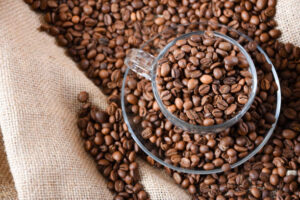Coffee lovers often face a dilemma when their trusty grinder breaks down or when they’re on vacation without their usual brewing setup. The question arises—can you grind coffee beans in a blender? This blog will uncover the answer, walking you through the process, its pros and cons, and offering some handy tips. If you’re looking to make the perfect cup of coffee without a grinder, stay tuned. We’ll explore everything you need to know about using a blender to grind your coffee beans and some FAQs to wrap up.
Can Blenders Really Do The Job?
The short answer is yes, you can grind coffee beans in a blender. Blenders are versatile kitchen tools, and many models come with powerful blades that can crush and grind various ingredients, including coffee beans. However, before you grab your blender and toss in your precious beans, there are a few things you should consider to ensure you get the best results.
Firstly, not all blenders are created equal. High-speed blenders with sharp blades and multiple speed settings work best. Brands like Vitamix and Ninja have proven to be particularly effective for this task. Secondly, be prepared for a different grinding consistency. While a dedicated coffee grinder offers precise control over the grind size, a blender may not provide the same level of uniformity. Blenders tend to produce a mix of sizes, from coarse to fine, which can affect the taste and brewing time of your coffee.
Finally, it’s essential to note that using a blender for grinding beans can generate heat, which may affect the coffee’s flavor. Coffee aficionados often stress that heat can lead to a loss of aromatic oils, impacting the overall taste.
How to Grind Coffee Beans in a Blender
Now that we’ve established that it’s possible, let’s walk through the steps to grind your coffee beans using a blender effectively.
Step 1: Choose the Right Blender
The success of your coffee grind largely depends on the type of blender you use. Opt for a high-speed blender with a powerful motor and sharp blades. Models with a pulse setting are ideal as they offer more control over the grinding process.
Step 2: Measure Your Beans
Determine the amount of coffee you need and measure your beans accordingly. For a standard cup of coffee, you’ll need about two tablespoons of coffee beans. Adjust the quantity based on your serving size.
Step 3: Add Beans to the Blender
Place the measured coffee beans into the blender’s container. It’s crucial not to overcrowd the blender, as this can lead to uneven grinding. If you’re making a large batch of coffee, it’s best to grind in smaller portions.
Step 4: Pulse the Beans
Rather than blending continuously, use the pulse setting to grind the beans. Pulse for a few seconds, then stop and check the grind size. This method allows you to control the fineness of the grind. For a coarser grind, pulse for a shorter duration; for a finer grind, pulse for longer.
Step 5: Check Your Grind
Once you’ve achieved your desired grind size, stop the blender and inspect the consistency. If necessary, give it another pulse to achieve uniformity. Remember, the longer you blend, the finer the grind will become.
Pros and Cons of Using a Blender
Like any method, grinding coffee beans in a blender has its advantages and disadvantages.
Pros of Using a Blender
- Convenience: Blenders are a common kitchen appliance, making them easily accessible when you don’t have a coffee grinder on hand.
- Versatility: Blenders can handle a variety of tasks, from making smoothies to grinding coffee beans, making them a versatile addition to your kitchen.
- Quick Results: With a powerful blender, you can grind coffee beans quickly and efficiently, saving you time, especially when you’re in a rush.
Cons of Using a Blender
- Inconsistent Grind Size: Unlike dedicated coffee grinders, blenders may produce uneven grind sizes, affecting the coffee’s taste and extraction.
- Heat Generation: Blenders can generate heat during the grinding process, potentially altering the coffee’s flavor profile.
- Wear and Tear: Grinding coffee beans can be tough on blender blades, potentially leading to faster wear and tear over time.
Tips for Better Results
To get the best possible results when grinding coffee beans in a blender, consider the following tips:
Use Fresh Beans
Freshly roasted coffee beans yield the best flavor. Ensure your beans are fresh for a more aromatic and flavorful cup of coffee.
Experiment with Pulse Duration
Since blenders don’t offer precise grind settings, it’s essential to experiment with the pulse duration to achieve your desired grind size. Start with short bursts and gradually increase the time if needed.
Clean the Blender Thoroughly
After grinding coffee beans, clean your blender thoroughly to remove any coffee residue. Coffee oils can cling to the blades and affect the taste of future blends.
Exploring Alternative Methods
While blenders can get the job done, there are other alternative methods to grind coffee beans if you don’t have a coffee grinder handy.
Manual Options
Consider using a mortar and pestle or a rolling pin. These manual methods require more effort but can provide a consistent grind size.
Spice Grinder
If you have a spice grinder, it’s a great alternative to a coffee grinder. Spice grinders are designed to handle smaller quantities, making them ideal for single servings.
Buying Pre-Ground Coffee
In a pinch, purchasing pre-ground coffee from your local grocery store or coffee shop is an option. While it may not be as fresh as grinding your own beans, it offers convenience.
Common Questions About Grinding Coffee Beans in a Blender
Does Grinding Coffee in a Blender Affect Flavor?
Grinding coffee beans in a blender can generate heat, affecting the flavor. To minimize this, use the pulse setting and avoid blending for extended periods.
Can I Grind Other Things in My Coffee Grinder?
It’s not recommended to use your coffee grinder for other ingredients like spices or herbs, as the flavors can mix. Instead, consider using a separate grinder for non-coffee items.
How Do I Clean My Blender After Grinding Coffee?
To clean your blender after grinding coffee, disassemble the parts and wash them thoroughly with warm, soapy water. Ensure all coffee residue is removed to maintain the flavor integrity of future blends.
Conclusion
In conclusion, using a blender to grind coffee beans is a viable option in a pinch. While it may not provide the same level of precision as a dedicated coffee grinder, it can still yield satisfactory results. By choosing the right blender, using the pulse setting, and following our tips, you can enjoy a freshly brewed cup of coffee even without a grinder. Experiment with different methods and find the one that suits your preferences best. Happy brewing!






